Excerpts from Jim Conrad's
Naturalist Newsletter
entry dated August 12, 2022, issued from near Tequisquiapan, elevation about 1,900m (6200 ft), N20.565°, W99.890°, Querétaro state, MÉXICO
WILD PERUVIAN ZINNIAS

Despite the rainy season having not yet arrived this year -- usually it comes in May -- so that much of the landscape remains crispy gray-brown, sometimes where the ground is low and sheltered from the hot wind, little weedy patches of greenness turn up. And sometimes such patches nowadays host the kind of wildflower shown above. Normally there's just one or two individuals in such weed communities. Before meeting with the above, I'd never seen so many of this species growing all together.
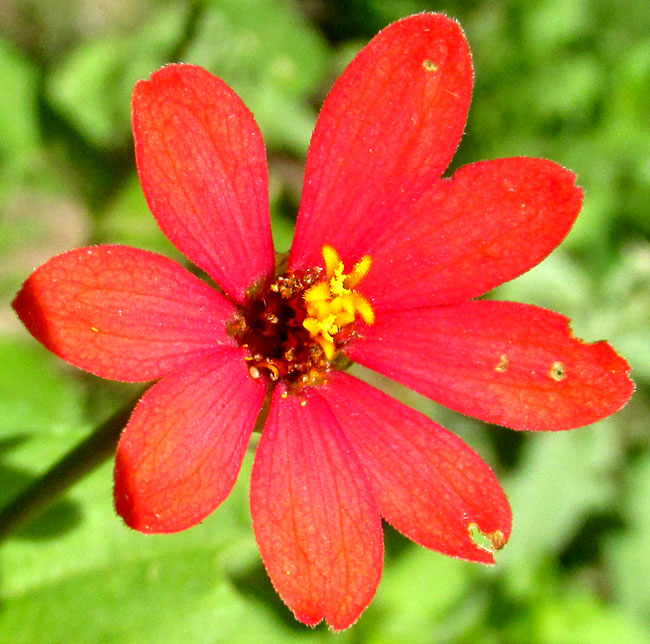
With flat, red, petal-like ray florets radiating from the blossom's center, and the center itself composed of cylindrical disc florets, with all the florets packed together into a capitulum-type head, this is clearly a member of the vast Composite or Aster Family, the Asteraceae. The capitulum viewed from below is a little surprising:
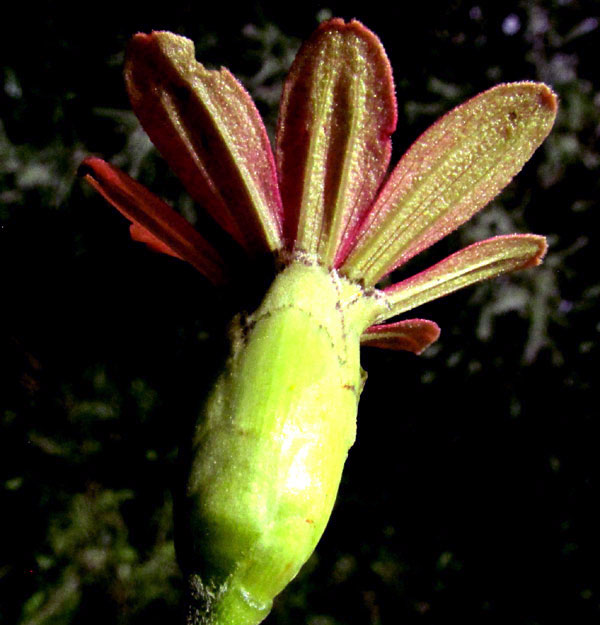
The ray florets' corolla undersurfaces are veiny and greenish. The green, urn-shaped involucre below them consists of scale-like bracts, or phyllaries, which are unusually smooth and broad, and rounded at their tops. The tops are highlighted with a thin, black edge.
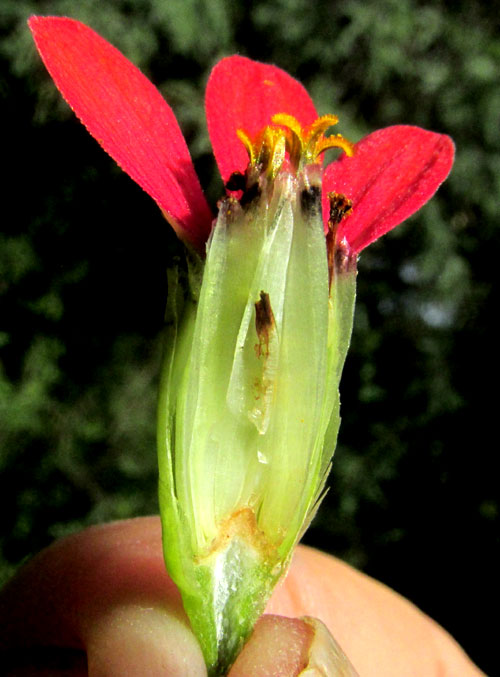
The above broken open capitulum shows remarkably large, pale, scoop-shaped paleae wrapping around the disc flowers. The paleae are black-tipped and the tips are broad and jagged as if cut by zigzag scissors. Just the tops of the disc flowers are visible, their cylindrical corollas each topped with short lobes that curve outwards, exposing hairy, orangish-yellow inner corolla-lobe surfaces. Maybe the paleae tips' blackness enables the yellow corolla lobes to attract pollinators better by highlighting them.
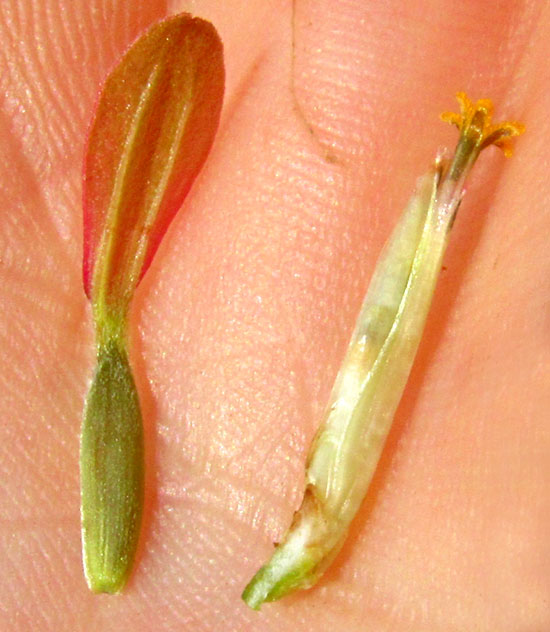
Above, on the right, you see a pale palea mostly surrounding a cylindrical disc floret. The immature, one-seeded, cypsela-type fruit at the bottom of the floret is flattish, while the cypsela below the ray floret's corolla on the left is three-angled. Both ray and disc floret cypselae produce viable seeds. Below is what the rough-hair stems and leaves look like:
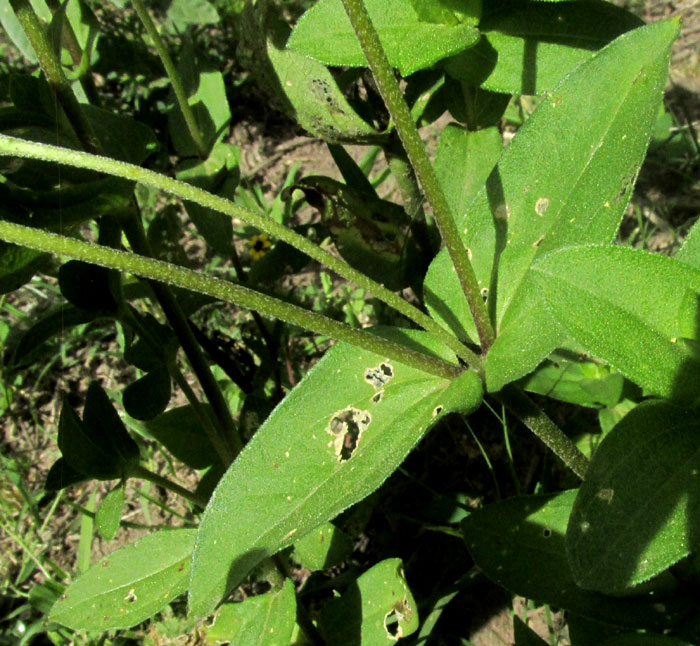
Gardeners will recognize all the above features as those of a zinnia, though a small-flowered one, and one with a less dazzling combination of colors than the usual garden cultivars. Here we have a natural, free-growing zinnia, not an escaped cultivar.
About 17 natural species of the genus Zinnia are recognized, all native just to the Americas, from the US south to Argentina. Of the 17 species, five occur in the US, and just in this semiarid upland region of central Mexico known as the Bajío we have about eight. In Querétaro state, if you have a herbaceous Zinnia with red ray florets, you have ZINNIA PERUVIANA, usually known in English as the Peruvian Zinnia. The species is distributed from the warmer parts of the southern US and the Caribbean area south deep into South America, plus it's introduced and invasive in numerous countries.
The authoritative online Invasive Species Compendium, CABI, has a History of introduction and spread section where it's explained that the Peruvian Zinnia's center of origin is Mesoamerica, and that it's likely that the species spread from here in Mexico northward into the US and southward into Guatemala. It notes that the species is absent "across the isthmus," presumably the isthmus between Panamá and South America, but reappears in the Andes, possibly thanks to migrating birds.
Our Peruvian Zinnia was the first zinnia species to be introduced into Europe, by the Spaniards, in the 1500s. However, it didn't catch on much as a garden plant. By the mid-1600s it was known throughout Europe but seldom cultivated, maybe because, as is written at the Harvesting-History.Com website, it "... was an altogether ugly sight, a sparsely foliated, rangy plant which produced small flowers whose petals were often various muddy shades of yellow and orange."
That's hard to read here where the species is a welcome little daub of color whenever it's encountered.
Of all the natural Zinnia species, only three are commercial money-makers: Zinnia elegans, Zinnia augustifolia and Zinnia haageana. Our Zinnia peruvianum hasn't contributed much to the horticultural gene-mixing resulting in today's situation where hybridization, back-crossing, gene modification and the like have lead to garden chrysanthemums, marigolds, zinnias and more all looking like fat, fluffy, gaudy-colored pompoms.
Though our little wildflower made it to Europe in the 1500s, it wasn't until 1759 that Linnaeus created the new genus Zinnia. It was named after Johann Gottfried Zinn, a professor in Germany who, having received a package of seeds of our plant sent from the German Ambassador to Mexico, grew the species and wrote the first description of it, though not naming it.
You may be interested in seeing the actual page from the 1759 Linnaeus publication entitled Systema naturae, per regna tria naturae, on which our plant was named, on file at the Biodiversity Heritage Library website. Apparently Linnaeus had first named it Chrysogonum peruvianum, but on that page was shifting it to the genus Zinnia. That accounts for why the full formal name for our plant is Zinnia peruviana (L.)L. -- twice named by Linnaeus. And twice calling our plant Peruvian, not Mexican.